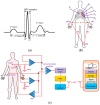Wearable Sensors for Remote Health Monitoring
- PMID: 28085085
- PMCID: PMC5298703
- DOI: 10.3390/s17010130
Wearable Sensors for Remote Health Monitoring
Abstract
Life expectancy in most countries has been increasing continually over the several few decades thanks to significant improvements in medicine, public health, as well as personal and environmental hygiene. However, increased life expectancy combined with falling birth rates are expected to engender a large aging demographic in the near future that would impose significant burdens on the socio-economic structure of these countries. Therefore, it is essential to develop cost-effective, easy-to-use systems for the sake of elderly healthcare and well-being. Remote health monitoring, based on non-invasive and wearable sensors, actuators and modern communication and information technologies offers an efficient and cost-effective solution that allows the elderly to continue to live in their comfortable home environment instead of expensive healthcare facilities. These systems will also allow healthcare personnel to monitor important physiological signs of their patients in real time, assess health conditions and provide feedback from distant facilities. In this paper, we have presented and compared several low-cost and non-invasive health and activity monitoring systems that were reported in recent years. A survey on textile-based sensors that can potentially be used in wearable systems is also presented. Finally, compatibility of several communication technologies as well as future perspectives and research challenges in remote monitoring systems will be discussed.
Keywords: ambulatory monitoring; body sensor network; remote health monitoring; smart textile; vital sign monitoring; wearable sensors.
Conflict of interest statement
The authors declare no conflict of interest.
Figures










References
-
- Centers for Disease Control and Prevention . The State of Aging and Health in America 2013. Centers for Disease Control and Prevention, US Department of Health and Human Services; Atlanta, GA, USA: 2013.
-
- Global Age Watch Index 2015. [(accessed on 20 June 2016)]. Available online: http://www.helpage.org/global-agewatch/
-
- World Health Organization Family Planning/Contraception. 2015. [(accessed on 20 June 2016)]. Available online: http://www.who.int/mediacentre/factsheets/fs351/en/
-
- World Health Organization Are You Ready? What You Need to Know about Ageing. World Health Day. 2012. [(accessed on 20 June 2016)]. Available online: http://www.who.int/world-health-day/2012/toolkit/background/en/
-
- U.S. Health Care Costs Rise Faster Than Inflation. [(accessed on 20 June 2016)]. Available online: http://www.forbes.com/sites/mikepatton/2015/06/29/u-s-health-care-costs-....
Publication types
MeSH terms
LinkOut - more resources
Full Text Sources
Other Literature Sources
Medical

